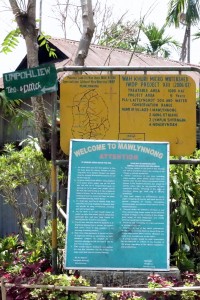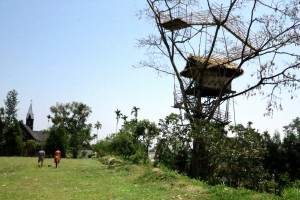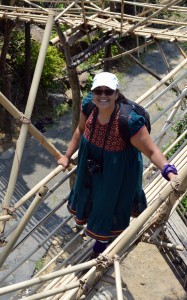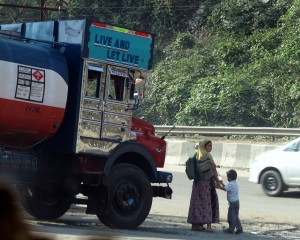
Welcome To Mawlynnong, “God’s own Garden”
Mawlynnong won an award a few years ago for being the cleanest village in Asia. It is proud of that designation, and rightly so. The village is almost utopian-like in its cleanliness. When we were hiking, we went quite far out of the town before I saw even one potato-chip bag or other piece of trash on the ground. In the rest of India, this would be incomprehensible.

Adorable bamboo trash bin
Photo by Alec Bernstein
Typically, in India, you don’t find trash cans anywhere, because trash goes everywhere. Essentially, the whole country is a dustbin – but not Mawlynnong! And the mentality extends a fair bit through much of the region as well. The homes have manicured gardens, things are tidy, and the villagers all look pretty happy and clean. They even have adorable woven bamboo trash cans all over the place!

I Need a Hammer
We passed a large group of men working on a house, and were fascinated to see the assembly line they had going to pass the concrete and bricks up along the roof. This definitely does not feel like the rest of India, as the three of us keep exclaiming!

Scorpion
The last morning in Mawlynnong, we saw a couple of things that were incredible. One of them was a scorpion larger than my hand.

That is one large spider!

Spider close-up
photo by Alec
The other was a spider. Its body was about 5 cms long – just the body, not the legs! It had a web between some trees that was at least one meter wide. (And we’d thought the one larger than a rupee the night before was big!)

Jayanthi and Alec by the Il-La-Jong Treehouse
In addition to the large bamboo structure at the Skyview where we are staying, there is another bamboo treehouse in town a little further up the hill. It is right next to the church and is part of another little hotel/resort, the I-La-Jong Guesthouse. This treehouse actually has a house in it – there is a little hut partway up with a door, bed, and window, but to get to it, you must cross a bridge that goes over the road. It’s made of several pieces of bamboo, all lashed together with the strands of “rope” made of palm.

Me Crossing Bridge in Treehouse Photo by Alec
Then, above the hut is another platform for viewing. From this one, you can see out to our resort’s platform and to Bangladesh beyond that, if the clouds aren’t low. We went up this on our last morning in Mawlynnong. From the treehouse, we were able to see Dean, coming back into town to pick us up for our return to Shillong! We flagged him down and he joined us up on the platform for a while. We were happy to see him again.
We had called Dean from Mawlynnong to see if he would drive us again and arranged to stay another night in Shillong before returning to Guwahati, having had such a great experience at the Hilltop Chateau on our first go-round. Alec and my schedule was still flexible for the second half of the trip. We were planning to travel north to Assam and visit Kaziranga National Park after dropping my sister in Guwahati. Jayanthi was going to return to Kolkata by plane as she had to work that week. After a little convincing and some flight changes, Jayanthi decided to extend her trip and call in to work so she could join us. We were all pretty thrilled with the revised plan, as we’d been having such a great trip.
 On the way back to Shillong, we stopped at the pork shop again. We were going to have lunch there, but after we ordered, Dean had the brilliant idea to have a picnic. And, like the most prepared Boy Scout, he had all the supplies we needed in his van. The ladies packed our food up for us and we drove into a beautiful spot in the forest a little ways down the road and stopped for a delicious meal in the woods! Yum!
On the way back to Shillong, we stopped at the pork shop again. We were going to have lunch there, but after we ordered, Dean had the brilliant idea to have a picnic. And, like the most prepared Boy Scout, he had all the supplies we needed in his van. The ladies packed our food up for us and we drove into a beautiful spot in the forest a little ways down the road and stopped for a delicious meal in the woods! Yum!

Woman and Kids near Gas Station
Dean also told me a great story told by the Khasi people about the betel nut. This is the nut chewed by the locals that makes most of them have dyed red teeth. In India, many people eat or chew paan, often after a meal. The betel nut is wrapped in the leaf, with a paste and several other things, such as coconut and sugar or anise seeds. The betel nuts are treated specially when they are dried and they are extremely hard. Some people also use a powdery form, more like chewing tobacco. When the paste and the nut are mixed, a red juice is created, and the result over time is stained teeth. Paan is popular throughout the country, but Dean said that it is in this area where it is grown and processed, and it takes a lot of time to prepare the nut correctly. We saw some places where the nuts were being soaked. Click here for a video of Dean telling me the Khasi story about the Betel nut. I learned a lot from Dean, our host and driver extraordinaire!

Kids in Meghalaya



